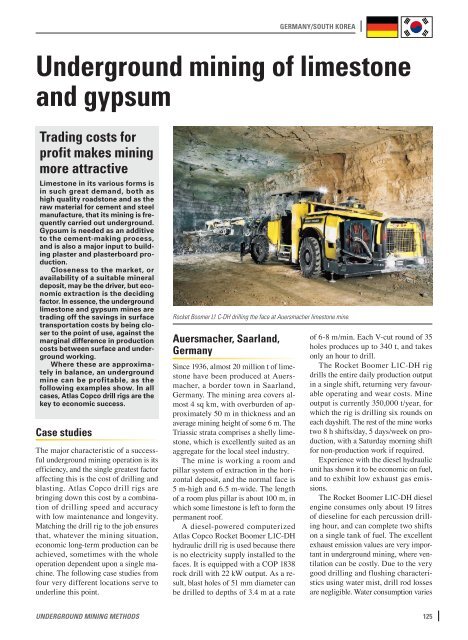Mining_Methods_UnderGround_Mining - Mining and Blasting
Mining_Methods_UnderGround_Mining - Mining and Blasting
Mining_Methods_UnderGround_Mining - Mining and Blasting
You also want an ePaper? Increase the reach of your titles
YUMPU automatically turns print PDFs into web optimized ePapers that Google loves.
gerMany/SOuTH kOrea<br />
underground mining of limestone<br />
<strong>and</strong> gypsum<br />
Trading costs for<br />
profit makes mining<br />
more attractive<br />
Limestone in its various forms is<br />
in such great dem<strong>and</strong>, both as<br />
high quality roadstone <strong>and</strong> as the<br />
raw material for cement <strong>and</strong> steel<br />
manufacture, that its mining is frequently<br />
carried out underground.<br />
Gypsum is needed as an additive<br />
to the cement-making process,<br />
<strong>and</strong> is also a major input to building<br />
plaster <strong>and</strong> plasterboard production.<br />
Closeness to the market, or<br />
availability of a suitable mineral<br />
deposit, may be the driver, but eco-<br />
nomic extraction is the deciding<br />
factor. In essence, the underground<br />
limestone <strong>and</strong> gypsum mines are<br />
trading off the savings in surface<br />
transportation costs by being closer<br />
to the point of use, against the<br />
marginal difference in production<br />
costs between surface <strong>and</strong> underground<br />
working.<br />
Where these are approxima-<br />
tely in balance, an underground<br />
mine can be profitable, as the<br />
following examples show. In all<br />
cases, Atlas Copco drill rigs are the<br />
key to economic success.<br />
Case studies<br />
The major characteristic of a successful<br />
underground mining operation is its<br />
efficiency, <strong>and</strong> the single greatest factor<br />
affecting this is the cost of drilling <strong>and</strong><br />
blasting. Atlas Copco drill rigs are<br />
bringing down this cost by a combination<br />
of drilling speed <strong>and</strong> accuracy<br />
with low maintenance <strong>and</strong> longevity.<br />
Matching the drill rig to the job ensures<br />
that, whatever the mining situation,<br />
economic long-term production can be<br />
achieved, sometimes with the whole<br />
operation dependent upon a single machine.<br />
The following case studies from<br />
four very different locations serve to<br />
underline this point.<br />
Rocket Boomer L1 C-DH drilling the face at Auersmacher limestone mine.<br />
auersmacher, Saarl<strong>and</strong>,<br />
germany<br />
Since 1936, almost 20 million t of lime-<br />
stone have been produced at Auers-<br />
macher, a border town in Saarl<strong>and</strong>,<br />
Germany. The mining area covers al-<br />
most 4 sq km, with overburden of approximately<br />
50 m in thickness <strong>and</strong> an<br />
average mining height of some 6 m. The<br />
Triassic strata comprises a shelly limestone,<br />
which is excellently suited as an<br />
aggregate for the local steel industry.<br />
The mine is working a room <strong>and</strong><br />
pillar system of extraction in the horizontal<br />
deposit, <strong>and</strong> the normal face is<br />
5 m-high <strong>and</strong> 6.5 m-wide. The length<br />
of a room plus pillar is about 100 m, in<br />
which some limestone is left to form the<br />
permanent roof.<br />
A diesel-powered computerized<br />
Atlas Copco Rocket Boomer L1C-DH<br />
hydraulic drill rig is used because there<br />
is no electricity supply installed to the<br />
faces. It is equipped with a COP 1838<br />
rock drill with 22 kW output. As a result,<br />
blast holes of 51 mm diameter can<br />
be drilled to depths of 3.4 m at a rate<br />
of 6-8 m/min. Each V-cut round of 35<br />
holes produces up to 340 t, <strong>and</strong> takes<br />
only an hour to drill.<br />
The Rocket Boomer L1C-DH rig<br />
drills the entire daily production output<br />
in a single shift, returning very favourable<br />
operating <strong>and</strong> wear costs. Mine<br />
output is currently 350,000 t/year, for<br />
which the rig is drilling six rounds on<br />
each dayshift. The rest of the mine works<br />
two 8 h shifts/day, 5 days/week on production,<br />
with a Saturday morning shift<br />
for non-production work if required.<br />
Experience with the diesel hydraulic<br />
unit has shown it to be economic on fuel,<br />
<strong>and</strong> to exhibit low exhaust gas emissions.<br />
The Rocket Boomer L1C-DH diesel<br />
engine consumes only about 19 litres<br />
of dieseline for each percussion drilling<br />
hour, <strong>and</strong> can complete two shifts<br />
on a single tank of fuel. The excellent<br />
exhaust emission values are very important<br />
in underground mining, where ven-<br />
tilation can be costly. Due to the very<br />
good drilling <strong>and</strong> flushing characteri-<br />
stics using water mist, drill rod losses<br />
are negligible. Water consumption varies<br />
underground mining methods 125
















